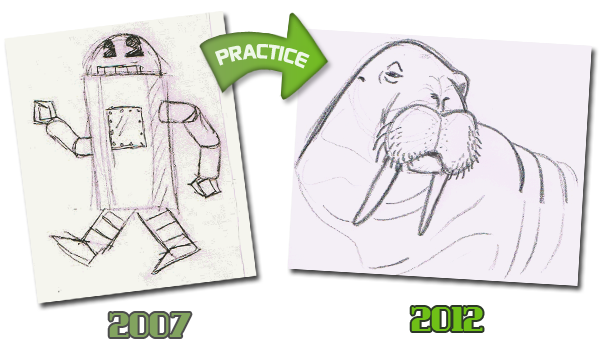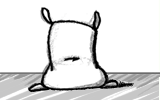Tips for Drawing: Change What You Want
The bad news: It’s the oldest advice in the world of art because it’s simply the truest of all. You have to practice if you want to get better at drawing. There’s just no way around it. Now for the good news: I’ve discovered secrets to practicing that transforms it into something less unbearable and frustrating!
First a short story: I struggled to practice drawing for about 10 years. And it was because of one singular reason: I wasn’t any good at it. Have you ever noticed how things you aren’t good at are some of the least fun things to do? That’s because we want to succeed. When we have to practice something we’re terrible at, we’re essentially willingly walking into failure. And we KNOW it. (Failure isn’t always a bad thing, though. Read more about failure here.) So what’s the solution? For me, for a long time, it was “don’t try.” I wasn’t good at drawing, it wasn’t fun to practice BECAUSE I wasn’t good at it, so I didn’t practice. And hence, I continued to not be good at it in a never ending cycle of wishing I was better at drawing. Well, it wasn’t NEVER ending…
Fast forward ten years (my where has the time gone?). Somewhere along the way I changed what I wanted. Instead of wanting “To be good at drawing” I wanted “To be better at drawing.” That might not seem like a big difference, but it’s actually huge.
Secret to Practicing: Change what you want.
By changing, in your own mind, from wanting to be GOOD to just wanting to be BETTER, you essentially set yourself up for success. By drawing, you automatically get better with every sketch. Which means, after I made the change, by practicing I was achieving my goal from Day One. I didn’t look at a sketch after I was finished and think “Oh, this isn’t any good, I failed,” I thought “This is better than some of the earlier pages in this sketchbook; I’m achieving my goal!” What a difference that makes. So right now, before you do anything else, change your goal. From now on you don’t want to be “good,” you want to be better. Go ahead and say it out loud to yourself. Make the change and see the difference it makes.

Good will come. Better will come quicker. Set yourself up for success.








Inspiring words. I was never very good at drawing but I always wanted to learn. Wish it didn’t take so long to get good!
I literally learned about a lot of this over the years, but never the less, I still thought this article was very useful. Excellent work!
Love this post. I look at it as taking baby steps, conquering problems, however small, one at a time. Eventually it adds up to one BIG step forward. I’m still very critical of my work(after all, we have to correctly identify issues in order to solve them), but keeping it to small, winnable baby steps has been one of the most important changes that I’ve ever made, and not just in drawing.
Excellent words, thank you for these encouraging advices
These are can be very helpful tips to change our life and
very useful to bearing against life’s bad surprises
Very good post, super helpful. Thanks!
That’s a real good way to look at it. Getting better instead of just magicley being better.
How much time does it take before I’m able to be viewed as a pro?
Heh, years and years and years. 🙂 Sorry, it’s a slow process!
Never thought about it that way! Sweet article.
such a simple change such a major difference. thanks for this article, it was a huge help.
I need to take this advice ASAP. I always have regrets and probably should try to just improve slow and steady.
What advice can you give for matching the proportions by eye that you can see on a model sheet or those that you can imagine from personality principles you’ve committed to memory (Preston Blair’s comes to mind)?
Can you suggest specific drawing exercises that will improve the ability to draw more accurately by eye alone without measuring? (Measuring is a pointless exercise for the majority of poses that contain some foreshortening.)
Sure! To keep it short and sweet (and maybe do a longer, more in depth post in the future) the biggest key is to look at simple shapes first. Not even 3D shapes, just 2D shapes and how they compare to each other. So for example, you might simplify the head and say “Okay, the head is this big” and then look at it next to the body and say “It’s around this size compared to the body.” Remember you can always add in details later, but early on it’s all about getting those proportions right.
Another great method is to draw straight from the model sheet A LOT. Over, and over, until the character’s forms are burned into your brain. From there it becomes easier to remember the proportions by eye. And keep in mind no one is perfect. Even the best animators often have to go back and put things on model after their first pass or two, so don’t beat yourself up if it doesn’t go as smoothly as you’d like. 🙂